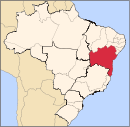This article has multiple issues. Please help improve it or discuss these issues on the talk page. (Learn how and when to remove these messages)
|
| Bahia | |
|---|---|
| State | |
 Flag Flag Coat of arms Coat of arms | |
| Motto(s): Per ardua surgo (Latin) "I rise through the hardship" | |
| Anthem: Hino da Bahia | |
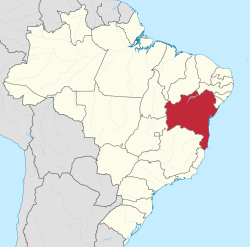 Location of State of Bahia in Brazil Location of State of Bahia in Brazil | |
| Coordinates: 12°S 41°W / 12°S 41°W / -12; -41 | |
| Country | |
| Capital and largest city | Salvador |
| Government | |
| • Governor | Jerônimo Rodrigues (PT) |
| • Vice Governor | Geraldo Júnior (MDB) |
| • Senators | Angelo Coronel (PSD) Jaques Wagner (PT) Otto Alencar (PSD) |
| Area | |
| • Total | 565,733 km (218,431 sq mi) |
| • Rank | 5th |
| Population | |
| • Total | 14,141,626 |
| • Rank | 4th |
| • Density | 25/km (65/sq mi) |
| • Rank | 15th |
| Demonym | Baiano |
| GDP | |
| • Total | R$ 352.618 billion (US$ 65.411 billion) |
| HDI | |
| • Year | 2021 |
| • Category | 0.691 – medium (22nd) |
| Time zone | UTC−03:00 (BRT) |
| Postal code | 40000-000 to 48990-000 |
| ISO 3166 code | BR-BA |
| License Plate Letter Sequence | JKS to JSZ, NTD to NTW, NYH to NZZ, OKI to OLG, OUF to OVD, OZC to OZV, PJA to PLZ, QTU to QTZ, RCO to RDR, RPA to RQL, SJJ to SKT |
| Website | www.bahia.ba.gov.br |
Bahia (Portuguese: [baˈiɐ] ) is one of the 26 states of Brazil, located in the Northeast Region of the country. It is the fourth-largest Brazilian state by population (after São Paulo, Minas Gerais, and Rio de Janeiro) and the 5th-largest by area. Bahia's capital is the city of Salvador (formerly known as "Cidade do São Salvador da Bahia de Todos os Santos", literally "City of the Holy Savior of the Bay of All the Saints"), on a spit of land separating the Bay of All Saints from the Atlantic. Once a stronghold of supporters of direct rule of Brazil by the Portuguese monarchy, and dominated by agricultural, slaving, and ranching interests, Bahia is now a predominantly working-class industrial and agricultural state. The state is home to 7% of the Brazilian population and produces 4.2% of the country's GDP.
Geography
Bahia is bordered on the east by the Atlantic Ocean. The Bay of All Saints is the largest bay on the Brazilian coast. Under the Brazilian Empire, it was bounded on the north by the Rio Real and by the Jequitinhonha on the south, but Bahia now comprises an irregular shape bound by other states of Brazil, some of which were formed from it. In the north, it is now bordered (from east to west) by Sergipe, Alagoas, Pernambuco and Piauí. In the northwest, it is bordered by Tocantins. In the southwest, it borders Goiás, and in the south it is bordered (from east to west) by Espírito Santo and Minas Gerais.
The state is crossed from west to east by many rivers, but the most important is the São Francisco, which starts in Minas Gerais and runs through western Bahia before emptying into the Atlantic between Sergipe and Alagoas. Formerly plied by paddlewheel steamers, the river is only navigable to small modern craft but is still vital to the arid west since it continuously supplies water during seasons. The Sobradinho Dam created one of the largest reservoirs in the world; other major hydroelectric projects along its length include the Paulo Afonso Hydroelectric Complex and the Itaparica or Luiz Gonzaga Dam.
Regions

Bahia's geographical regions comprise the Atlantic Forest; the maritime region (Recôncavo) radiating from the Bay of All Saints, the site of sugar and tobacco cultivation; and the Planalto, which includes the sertão region of Bahia's far interior. The state has the Diamantina Tableland (Chapada Diamantina), which divides it into two distinct geographical zones. The rain falls regularly in the eastern section. The western area is more arid and its predominate vegetation the cerrado. The natural aridity was greatly worsened over the 19th century by the cowboys' habit of starting wildfires each year to improve the quality of the grass. The Chapada Diamantina National Park is home to picturesque chapadões.
Climate
Bahia's climate is tropical. It has the longest coastline of the country: 1,103 km long (685 miles; north coast: 143; Bay of All Saints: 124; and southern: 418). With 68% of its territory located in the semi-arid zone, the State presents diversified climates and an average rainfall that varies from 363 to 2,000 mm (14.3 to 78.7 in) per year, depending on the region.
| This section contains an unencyclopedic or excessive gallery of images. Please help improve the section by removing excessive or indiscriminate images or by moving relevant images beside adjacent text, in accordance with the Manual of Style on use of images. (January 2024) (Learn how and when to remove this message) |
-
 Fumaça Waterfall
Fumaça Waterfall
-
 View of Morro de São Paulo
View of Morro de São Paulo
-
 View of Salvador
View of Salvador
-
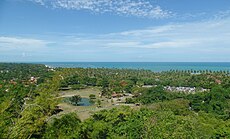 Arraial D'Ajuda coast in Porto Seguro
Arraial D'Ajuda coast in Porto Seguro
-
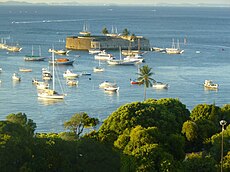 São Marcelo Fort, in the capital of the state
São Marcelo Fort, in the capital of the state
History


The Portuguese Pedro Álvares Cabral sighted Monte Pascoal ("Easter Mountain") near Itamaraju and landed at what is now Porto Seguro on the southern coast of Bahia in 1500, claiming the territory for Portugal. In 1549, Portugal established the city of Salvador on a hill facing the Bay of All Saints. The city and surrounding captaincy served as an administrative capital of Portugal's colonies in the Americas until 1763. It remained the religious capital of Brazil's Roman Catholic hierarchy, with its archbishop serving as the national primate until 1907. Salvador holds the country's oldest cathedral and first medical college (1810), and an engineering school was established in 1899.
Bahia's captaincy was the first to fail, with its lands reverting to the Portuguese crown in 1549. While Portugal was united with Spain, the Dutch West India companies tried to conquer Bahia but was unsuccessful in the area, with Dutch Brazil restricted to the area from Pernambuco Northward.
Bahia was a center of sugarcane cultivation from the 16th to the 18th centuries and contains a number of historic towns, such as Cachoeira, dating from this era. Integral to the sugar economy was the importation of a vast number of African slaves: more than a third of all slaves taken from Africa were sent to Brazil, mostly to be processed in Bahia before being sent to work in plantations elsewhere in the country.
The state was the last area of the country to join the Empire of Brazil, as members in the local elite remained loyal to the Portuguese crown after the rest of the country proclaimed independence under Pedro I on 7 September 1822. Control of the province was disputed in several battles, mostly in Pirajá, before the Portuguese were fully expelled on 2 July 1823. It became a Brazilian state in 1889.
Charles Darwin visited Bahia in 1832 on his famous voyage on the Beagle. In 1835, Bahia was the site of an urban slave revolt, the Malê Revolt of 1835 by the predominantly Muslim West African slaves at the time. The term malê was commonly used to refer to Muslims at the time from the Yoruba word imale. The revolt is particularly notable as the greatest slave rebellion in the history of the Bahia. Under the Empire, Bahia returned 14 deputies to the general assembly and 7 senators; its own provincial assembly consisted of 36 members. In the 19th century, cotton, coffee, and tobacco plantations joined those for sugarcane and the discovery of diamonds in 1844 led to large influx of "washers" (garimpeiros) until the still-larger deposits in South Africa came to light. A smaller boom hit Caetité in 1872 upon the discovery of amethysts there. The cattle industry of the interior led to the development of Feira de Santana before collapsing in a series of droughts.
Politics
| This section does not cite any sources. Please help improve this section by adding citations to reliable sources. Unsourced material may be challenged and removed. (January 2024) (Learn how and when to remove this message) |
Historically, Bahia's politics and that of the country have been closely intertwined, initially due to Salvador's status as the first capital of Brazil. During the imperial period, several prime ministers originated from Bahia; during the early years of the Republic, Bahia produced some noteworthy national figures, such as Ruy Barbosa, Cezar Zama, and Aristides Spínola, amongst others.
During the First Brazilian Republic (República Velha) the biggest name in the state's politics was José Joaquim Seabra, also known as J. J. Seabra; the Vargas era and the subsequent re-democratization period saw the rise of Juracy Magalhães and Otávio Mangabeira, respectively. During the military dictatorship, the governorship of Antônio Carlos Magalhães (also known by his initials, ACM) marked the politics of Bahia for three decades, with one brief defeat in 1980 by Waldir Pires. Despite this defeat ACM later occupied many other public offices; he died in 2007 while serving as senator. ACM's wide-reaching influence in the state's politics has been dubbed "Carlismo", and is considered an example of a larger phenomenon called coronelismo ("colonel-ism").
After the end of military rule in Brazil in 1985, the government of the state of Bahia oscillated between two parties, the Partido da Frente Liberal (PFL, now the Democrats) and the Brazilian Democratic Movement (MDB). The Workers' Party (PT) was elected to the governorship in 2007 and has held it ever since, through five successive elections (2006, 2010, 2014, 2018, and 2022).
Government structure
As a federative unit of Brazil, Bahia has its own three branches of government (executive, legislative, judiciary), which are operated by the Governor, the Legislative Assembly and the Court of Justice of the State of Bahia, respectively. Elected terms last four years, with state and federal elections being held simultaneously. The governor of the state is limited to two consecutive terms. The Legislative Assembly is composed of 63 state deputies. At the federal level, Bahia is represented by three senators and 39 federal deputies. Municipal elections are held two years after the state and federal elections.
The state capital is the city of Salvador, but once a year the capital is moved to Cachoeira in recognition of the city's importance in the struggle for the independence of Brazil.
There are 10,110,100 registered voters, according to data from 2012, making Bahia the state with the fourth highest number of voters in the country. Most voters reside in the capital (and most populous city), Salvador.
All 29 parties registered in Brazil have chapters in Bahia.
Demographics
| Year | Pop. | ±% |
|---|---|---|
| 1872 | 1,379,616 | — |
| 1890 | 1,919,802 | +39.2% |
| 1900 | 2,117,956 | +10.3% |
| 1920 | 3,334,465 | +57.4% |
| 1940 | 3,918,112 | +17.5% |
| 1950 | 4,834,575 | +23.4% |
| 1960 | 5,990,605 | +23.9% |
| 1970 | 7,583,140 | +26.6% |
| 1980 | 9,597,393 | +26.6% |
| 1991 | 11,855,157 | +23.5% |
| 2000 | 13,085,769 | +10.4% |
| 2010 | 14,016,906 | +7.1% |
| 2022 | 14,141,626 | +0.9% |
| Source: | ||
According to IBGE data of 2022, there were 14,141,626 people residing in the state. The population density was 24.93 inhabitants per square kilometre (64.6/sq mi). Urban population: 67.4% (2006); Population growth: 1.1% (1991–2000); Houses: 3,826,000 (2006). The last National Census in 2022 showed the following numbers: 8,103,964 Brown (Multiracial) people (57.3%), 2,772,837 White people (19.60%), 3,164,691 Black people (22.4%), 83,658 Amerindian people (0.6%).
According to Instituto Socioambiental, there are 14 Indigenous groups in the state: Atikum, Kaimbé, Kantaruré, Kiriri, Pankaru, Pankararé, Pataxó, Pataxó Hã-ha- hãe, Payayá, Truká, Tumbalalá, Tupinambá, Tuxá and Xukuru-Kariri.
Historically, the population was estimated at 1.45 million in the 1870s and was 1.92 million at the time of the 1890 Brazilian census.
Public safety
Bahia has one of the highest crime rates in the country, having four of the ten most violent cities in Brazil. Gun violence in the state more than doubled from 2004 to 2014, ranking first out of the 26 states of Brazil. In 2014, the state also had the highest number of murders in the country.
Largest cities
| Largest cities or towns in Bahia (2014 census by the Brazilian Institute of Geography and Statistics) | |||||||||
|---|---|---|---|---|---|---|---|---|---|
| Rank | Mesoregion | Pop. | Rank | Mesoregion | Pop. | ||||
 Salvador  Feira de Santana |
1 | Salvador | Salvador | 2,902,927 | 11 | Alagoinhas | Nordeste | 153,560 | Vitória da Conquista  Camaçari |
| 2 | Feira de Santana | Centro-Norte | 612,000 | 12 | Barreiras | Extremo Oeste | 152,208 | ||
| 3 | Vitória da Conquista | Centro-Sul | 340,199 | 13 | Porto Seguro | Sul | 143,282 | ||
| 4 | Camaçari | Salvador | 281,413 | 14 | Simões Filho | Salvador | 131,630 | ||
| 5 | Itabuna | Sul | 218,925 | 15 | Paulo Afonso | São-Franciscana | 118,323 | ||
| 6 | Juazeiro | São-Franciscana | 216,588 | 16 | Eunápolis | Sul | 112,032 | ||
| 7 | Lauro de Freitas | Salvador | 188,013 | 17 | Santo Antônio de Jesus | Salvador | 100,550 | ||
| 8 | Ilhéus | Sul | 182,350 | 18 | Valença | Sul | 96,507 | ||
| 9 | Jequié | Centro-Sul | 161,150 | 19 | Candeias | Salvador | 88,308 | ||
| 10 | Teixeira de Freitas | Sul | 155,659 | 20 | Guanambi | Centro-Sul | 85,237 | ||
Religion in Bahia (2010)
Catholicism (65.2%) Protestantism (17.4%) Spiritism (1.1%) Other (4.3%) Unaffiliated (12.0%)Education
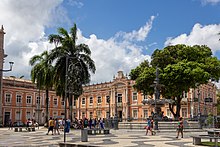
Educational institutions
| This list is incomplete; you can help by adding missing items. (July 2024) |
- Centro Universitário da Bahia (FIB; University Centre of Bahia)
- Escola Bahiana de Medicina e Saúde Pública (EBMSP; Bahian School of Medicine and Public Health)
- Federal do Vale do São Francisco
- Instituto Federal da Bahia (IFBA)
- Instituto Federal Baiano (IFBAIANO)
- Universidade Católica de Salvador (UCSal; Catholic University of Salvador)
- Universidade do Estado da Bahia (UNEB; Bahia State University)
- Universidade Estadual de Feira de Santana (UEFS; State University of Feira de Santana)
- Universidade Estadual de Santa Cruz (UESC; State University of Santa Cruz)
- Universidade Estadual do Sudoeste da Bahia (Uesb; State University of Southwest of Bahia)
- Universidade Federal da Bahia (UFBA; Federal University of Bahia)
- Universidade Federal do Recôncavo da Bahia (UFRB; Federal University of Recôncavo da Bahia)
- Universidade Salvador (Unifacs; Salvador University)
Culture
| This article needs additional citations for verification. Please help improve this article by adding citations to reliable sources. Unsourced material may be challenged and removed. Find sources: "Bahia" – news · newspapers · books · scholar · JSTOR (January 2024) (Learn how and when to remove this message) |
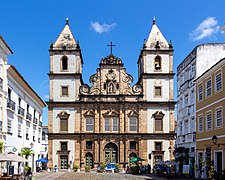 Church and Convent of São Francisco in Salvador
Church and Convent of São Francisco in Salvador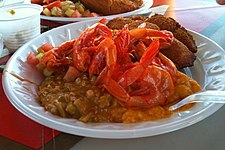 Acarajé is a symbol of cuisine from Bahia
Acarajé is a symbol of cuisine from Bahia
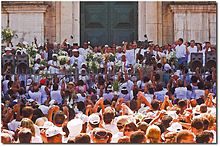

As the chief locus of the early Brazilian slave trade, Bahia is considered to possess the greatest and most distinctive African imprint, in terms of culture and customs, in Brazil. These include the Yoruba-derived religious system of Candomblé, the capoeira (martial art emerged in Quilombo dos Palmares, located in the state of Alagoas ), African-derived music such as samba (especially Brazilian samba precursor, the samba-de-roda), afoxé, and axé, and a cuisine with strong links to western Africa.
In the interior of the state, there is the traditional culture of the vaqueiros among agricultural communities. From the 1550s onward, in Bahia, these farmers were integral to the process of expansion away from the coasts of Brazil.
Arts

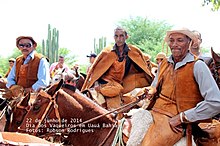
Bahia is the birthplace of many noted Brazilian artists, writers and musicians. Among the noted musical figures born in the state are Dorival Caymmi, Joao Gilberto, Gilberto Gil, Raul Seixas, Pepeu Gomes, Margareth Menezes, Daniela Mercury, Carlinhos Brown, Ivete Sangalo, and Pitty.
The city of Salvador is also home to groups known as "blocos-afros", including Olodum, Timbalada, and Ilê Aiyê. Additionally, groups such as Novos Baianos, Chiclete com Banana, Camisa de Vênus, Banda Eva, BaianaSystem are based in Bahia. The first well-known rock'n roll singer in Brazil was also from Bahia. Born Raul Seixas, he was known as "Maluco Beleza" or "Peaceful Lunatic" (being "beleza (beauty)" in this manner means to be either "in peace" or "tranquil").
During the 19th century, one of Brazil's greatest poets, the Bahian abolitionist poet and playwright Castro Alves, a native of the recôncavo city of Cachoeira, penned his poem, Navio negreiro, about slavery; the poem is considered a masterpiece of Brazilian Romanticism and a central anti-slavery text.
Other notable Bahian writers include playwright and screenwriter Dias Gomes, Gregório de Matos, who wrote during the 17th century and was one of the first Brazilian writers, and Fr. António Vieira, who during the colonial period was one of many authors who contributed to the expansion of the Portuguese language throughout the Brazilian territory.
One of Brazil's most prominent writers of the 20th century, Jorge Amado, was born in the southeastern Bahian city of Itabuna, and resided for many years in Salvador. His major novels include Gabriela, Clove and Cinnamon; Dona Flor and Her Two Husbands; and Tieta, the Goat Girl, all of which became internationally renowned films. Other notable authors from Bahia include the fiction writers João Ubaldo Ribeiro and historic writer Euclides da Cunha, who wrote "Os Sertões".
In the visual and plastic arts, one of the best known Bahian figures was the multigenre artist and Argentinian native Hector Julio Páride Bernabó, also known as Carybé (1911–1997). Fine examples of his work are visible in the Afro-Brazilian Museum in Salvador.
The baiano film director, actor, and screenwriter, Glauber Rocha, was one of the most influential moviemakers of Brazilian cinema and a key figure of Cinema Novo. His films Black God, White Devil and Entranced Earth are often considered to be two of the greatest achievements in Brazilian cinematic history, being selected by Abraccine as, respectively, the second and fifth best Brazilian films of all-time.
Tourism and recreation
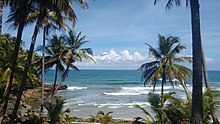



There is a World Heritage Site in Salvador. Pelourinho was once Salvador's principal red-light district as well as a working-class neighborhood that was home to thousands of Afro-Brazilians. Since 1992, however, the overwhelming majority of these people have been forcibly removed and replaced by boutiques, NGO headquarters, government offices, folkloric representations, monuments, and amenities for tourists.
Economy
In 2004, Bahia comprised 4.9% of the economic activity of Brazil and it has the biggest GDP of the states of the North and Northeast. The industrial sector is the largest component of GDP at 48.5%, followed by the service sector at 40.8%. Agriculture represents 10.7% of GDP (2004). Bahia exports: chemicals 22.4%, fuel 17.5%, mineral metallics 13%, paper 9.4%, cacao 5.6%, vehicles 4.8%, soybean 4.5% (2002). In addition to important agricultural and industrial sectors, the state also has considerable mineral and petroleum deposits. In recent years, soy cultivation has increased substantially in the state.
During the colonial and imperial periods, Bahia was a center of Brazilian sugarcane production and slave trading. In the 19th century, the Bay of All Saints was also a whaling spot, as some species of whales used the bay as a mating ground. By that time, the province was also growing cotton, coffee, and tobacco with great success. mandioc, rice, beans, and corn, saffron, oranges, mangoes, and other fruit were grown for local consumption. The arid interior was mostly used for cattle-farming, but this was ruined by a series of droughts caused in part by the custom of starting annual wildfires to improve the grass. Diamonds, gold, and amethysts were panned for in the rivers, while coal was mined on Itaparica. cacao was being farmed by the time of the First World War. It grew more than the national average, due to the fact that the state was previously below the average level.
In agriculture, the state stands out in the production of cotton, cocoa, soy and tropical fruits such as coconut, papaya, mango, banana and guarana, in addition to also producing sugar cane, orange, beans and cassava, among others.
In 2017, the Northeast Region was the largest producer of coconut in the country, with 74.0% of national production. Bahia produced 351 million fruits, being the leader in the country. However, the sector has been suffering strong competition and losing market to Indonesia, the Philippines and India, the world's largest producers, who even export coconut water to Brazil. In addition to climatic problems, the low productivity of coconut palms in the Northeast Region is the result of factors related to the variety of coconut harvested and the technological level used in coastal regions. In these areas, the semi-extractive cultivation system still prevails, with low fertility and without the adoption of cultural management practices. The three states that have the largest production, Bahia, Sergipe and Ceará, present a yield three times lower than that of Pernambuco, which is in 5th place in the national production. This is because most of the coconut trees in these three states are located in coastal areas and cultivated in semi-extractivist systems.
In the production of cocoa, for a long time, Bahia led the Brazilian production. Today, it is disputing the leadership of national production with the state of Pará. In 2017 Pará obtained the leadership for the first time. In 2019, people from Pará harvested 135 thousand tons of cocoa, and Bahians harvested 130 thousand tons. Bahia's cocoa area is practically three times larger than that of Pará, but Pará's productivity is practically three times greater. Some factors that explain this are: the crops in Bahia are more extractivist, and those in Pará have a more modern and commercial style, in addition to paraenses using more productive and resistant seeds, and their region providing resistance to Witch's broom.
In 2018, the Northeast was in third place among the regions that most produce sugar cane in the country. Brazil is the world's largest producer, with 672.8 million tons harvested this year. The Northeast harvested 45.7 million tons, 6.8% of national production. Alagoas is the largest producer, with 33.3% of Northeastern production (15.2 million tons). Pernambuco is the 2nd largest producer in the Northeast, with 22.7% of the total in the region (10.3 million tons). Paraíba has 11.9% of northeastern production (5.5 million tons) and Bahia, 10.24% of production (4.7 million tons).
Bahia is the 2nd largest producer of cotton in Brazil, losing only to Mato Grosso. In 2019, it harvested 1.5 million tonnes of the product.
In soy, Brazil produced close to 120 million tons in 2019, being the largest world producer. In 2019, the Northeast produced close to 10.7 million tons, or 9% of the Brazilian total. The largest producer in the Northeast was Bahia (5.3 million tons).
In the production of maize, in 2018 Brazil was the 3rd largest producer in the world, with 82 million tons. The Northeast produced about 8.4% of the country's total. Bahia was the largest producer in the Northeast, with 2.2 million tons.
In 2018, the South Region was the main producer of beans with 26.4% of the total, followed by the Midwest (25.4%), Southeast Region (25.1%), Northeast (20.6%) and North (2.5%). The largest producers in the Northeast were Ceará and Bahia.
In cassava production, Brazil produced a total of 17.6 million tons in 2018. Maranhão was the 7th largest producer in the country, with 681 thousand tons. Ceará was 9th, with 622 thousand tons. Bahia was 10th with 610 thousand tons. In total, the northeast produced 3,5 million tons.
Bahia was the fourth largest producer of oranges in Brazil in 2018, with a total of 604 thousand tons, 3,6% of the national production.
Bahia is the second largest fruit producer in the country, with more than 3.3 million tons a year, behind São Paulo. The north of Bahia is one of the main fruit suppliers in the country. The State is one of the main national producers of ten types of fruit. In 2017, Bahia led the production of cajarana, coconut, count fruit or pinecone, soursop, umbu, jackfruit, licuri, mango and passion fruit, and is in second place in cocoa almond, atemoia, cupuaçu, lime and lemon, and third in banana, carambola, guava, papaya, watermelon, melon, cherry, pomegranate and table grapes. In all, 34 products from Bahia's fruit culture have an important participation in the national economy.
Rio Grande do Norte is the largest producer of melon in the country. In 2017 it produced 354 thousand tons. The Northeast region accounted for 95.8% of the country's production in 2007. In addition to Rio Grande do Norte, which in 2005 produced 45.4% of the country's total, the other 3 largest in the country were Ceará, Bahia and Pernambuco.
In the production of papaya, in 2018 Bahia was the 2nd largest producer state in Brazil, almost equaling with Espírito Santo: 337 thousand tons.
Bahia was the largest producer of mango in the country in 2019, with production of around 281 thousand tons per year. Juazeiro (130 thousand tons per year) and Casa Nova (54 thousand tons per year) are at the top of the list of Brazilian cities that lead the cultivation of fruit.
In the production of banana, in 2018 Bahia was the 2nd largest national producer.
Bahia is the largest Brazilian producer of guaraná. In 2017, Brazilian production was close to 3.3 million tons. Bahia harvested 2.3 million (mainly in the city of Taperoá), Amazonas 0.7 million (mainly in the city of Maués) and the rest of the country, 0.3 million. Despite the fact that the fruit originated in the Amazon, since 1989 Bahia has beaten Amazonas in terms of production volume and guarana productivity, due to the fact that the soil in Bahia is more favorable, in addition to the absence of diseases in the region. The most famous users of the product, however, acquire 90% to 100% of their guarana from the Amazon region, such as Ambev and Coca-Cola. Bahian guarana prices are well below those of other states, but Sudam's tax exemptions lead the beverage industry to prefer to purchase seeds in the North, which helps maintain the highest added value of Amazonian guarana. The pharmaceutical industries and importers, on the other hand, buy more guarana from Bahia, due to the price.
The Northeast region housed 93.2% of the Brazilian goat herd (8,944,461 heads) and 64.2% of the sheep herd (11,544,939 heads) in 2017. Bahia concentrated 30.9% of the goat herd and 20.9% of the national sheep herd. Casa Nova took first place in the municipal ranking with the largest numbers of both species.
In 2017, Bahia had 1.68% of the national mineral participation (4th place in the country). Bahia had production of gold (6.2 tons at a value of R$730 million), copper (56 thousand tons, at a value of R$404 million); chrome (520 thousand tons, at a value of R$254 million) and vanadium (358 thousand tons, at a value of R$91 million).
Bahia had an industrial GDP of R$53.0 billion in 2017, equivalent to 4.4% of the national industry. It employs 356,997 workers in the industry. The main industrial sectors are: Construction (24.8%), Industrial Services of Public Utility, such as Electricity and Water (15.0%), Petroleum Derivatives and Biofuels (13.8%), Chemicals (9.4%), and Food (6.1%). These 5 sectors concentrate 69.1% of the state's industry.
Bahian industry have automobile and tyre industries, footwear and textiles, furniture, food and beverages, cosmetics and perfumes, information technology and naval sectors.
In Brazil, the automotive sector represents close to 22% of industrial GDP. Bahia has a Ford factory. It was created in Camaçari (2001). The Bahian automotive sector, led by Ford was in 2005 the third largest contributor (14.6%) to the Bahian GDP.
-
 Cotton in Luís Eduardo Magalhães
Cotton in Luís Eduardo Magalhães
-
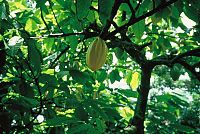 Cocoa in Ilhéus
Cocoa in Ilhéus
-
Coconut production
-
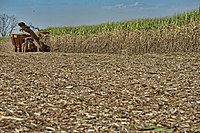 Sugarcane in Bahia
Sugarcane in Bahia
-
 Soy plantation in Barreiras
Soy plantation in Barreiras
-
 Pineapple plantation
Pineapple plantation
-
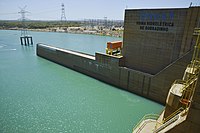 Hydroelectric power plant in Sobradinho.
Hydroelectric power plant in Sobradinho.
-
Goats in Araci
-
 Alstom factory in Camaçari
Alstom factory in Camaçari
Chemical and petrochemical

Bahia's Petrochemical Pole is the largest integrated complex in the Southern Hemisphere, and is the result of R$10 billion in investments, accounting for a third of the state's exports and for nearly half of the industrial production value.
Reconcavo Basin
The Reconcavo Basin has been a principal petroleum-producing region, mainly from the Upper Jurassic and Lower Cretaceous Bahia Supergroup, since 1939 and contains the Agua Grande Field (discovered in 1951 by the Conselho Nacional de Petroleo and producing from the Sergei and Candeias Formations at about 1 km depth and the shallower Ilhas Formation), the Dom Joao Field (discovered in 1947 by the Conselho Nacional de Petroleo and producing from the Sergei Formation at a depth of about 200 m), the Miranga Field (discovered in 1965 by Petrobras producing from the Ilhas Formation at a depth of about 1 km), the Candeias Field (discovered in 1941 by Conselho Nacional de Petroleo and producing from the Candeias Formation at a depth ranging from 690 to 2400 m), the Buracica Field (discovered in 1959 by Petrobras and producing from the Sergi Formation at about 600 m depth), and the Taquipe Field (discovered in 1958 by Petrobras and producing from the Ilhas Formation).
Other market segments
Agribusiness; footwear; call centers; informatics, electronics, and telecommunications; nautical; paper and pulp; textiles; plastic transformation; and tourism.
Infrastructure
Airports
Deputado Luís Eduardo Magalhães International Airport is located in an area of more than 6 million square meters (1,500 acres). It lies 20 km (12 mi) north of downtown Salvador. In 2007, the airport handled 5,920,573 passengers and 91,043 aircraft movements, making it the fifth busiest airport in Brazil in terms of passengers. It's responsible for more than 30% of passenger movement in northeastern Brazil. Nearly 35,000 people circulate daily through the passenger terminal. The airport generates more than 16,000 direct and indirect jobs, to serve a daily average of over 10,000 passengers, 250 takeoffs and landings of 100 domestic and 16 international flights.
The international airlines are Lufthansa, TAP, United Airlines, American Airlines, Alitália, Air France, Air Europa, Ibéria, Aerolíneas Argentinas, LanChile. In addition to domestic and regional services, the airport has non-stop flights to Lisbon, Madrid, Frankfurt, Montevideo, London, Santiago, Buenos Aires, Asunción and Miami. Its IATA airport code is SSA and it is the sixth busiest airport in the country, the first in northeastern Brazil, behind Congonhas International, Guarulhos International, Juscelino Kubitschek International, Santos Dumont Regional and Galeão International.
Bahia also has some smaller modern regional airports including Ilhéus Jorge Amado Airport and Porto Seguro Airport.
Highways

The state has its transportation based on highways, with few options in other sectors. The main highways in the state are all from the Federal Government:
- BR-101 – It borders the state coast, connecting it with the country's richest region (Southeast) and with the rest of the Northeast. It passes through the cocoa producing area of the state, in the cities of Itabuna and Ilhéus, reaching the capital Salvador and from there to Aracaju, capital of Sergipe.
- BR-116 – also crosses the state from north to south, parallel to BR 101 but passing further inland. It cuts through some of the important cities of the state, such as Vitória da Conquista, Jequié, Feira de Santana and Euclides da Cunha, going towards the interior of Pernambuco and Fortaleza, capital of Ceará.
- BR-242 – the highway cuts the state in half in an east–west direction, connecting Salvador to Brasília, the country's capital. It passes through important cities like Lençóis, Barreiras and Luís Eduardo Magalhães.
- BR-407 – together with BR-324, the highway connects the region of Bahia, which is the largest producer of fruit and the largest breeder of sheep and goats, in the cities of Juazeiro and Casa Nova, to Feira de Santana, Salvador and southeastern Brazil. The BR-235 borders the North of the state, connecting these same regions to the coast of Bahia.
- BR-110 – crossing the interior of the Northeast Region, this highway connects Salvador with the hydroelectric plant of Paulo Afonso and reaches Mossoró, in Rio Grande do Norte
Also noteworthy is the BR-030, which crosses the south of Bahia in an east–west direction.
Ports

With cargo volume that grows year after year following the same economic development rhythm implemented in the State, the Port of Salvador, located on the Bay of All Saints, holds status as the port with the highest movement of containers of the North/Northeast and the second-leading fruit exporter in Brazil. The port's facilities operate from 8 a.m. to noon and from 1:30 a.m. to 5:30 p.m.
The ability to handle high shipping volume has positioned the port of Salvador for new investments in technological modernization, and the port is noted for implementing a high level of operational flexibility and competitive rates. The goal of port officials is to offer the necessary infrastructure for the movement of goods, while simultaneously meeting the needs of international importers and exporters.
Sports
| This section does not cite any sources. Please help improve this section by adding citations to reliable sources. Unsourced material may be challenged and removed. (September 2022) (Learn how and when to remove this message) |

Football is the most popular sport. The two most popular football teams are EC Bahia and EC Vitória, in the Campeonato Brasileiro Série A (first division). EC Bahia has won two league titles in 1959 and 1988. EC Vitória was runner up of the Série A in 1993 and champion of the Série B (second division) in 2023.
Bahia is renowned for its mixed martial arts fans, with prominent fighters from this state including former heavyweight champion of both Pride Fighting Championship and Ultimate Fighting Championship Antônio Rodrigo Nogueira, his twin brother Antônio Rogério Nogueira, and former Ultimate Fighting Championship Heavyweight Champion Junior dos Santos. In the sport of boxing, Bahian native Acelino Freitas has won the WBC belt in the lightweight class. In the Capoeira world, the actor and Capoeira Master, Lateef Crowder dos Santos is an American born in Salvador, Bahia.
Salvador was one of the host cities of the 2014 FIFA World Cup, for which Brazil was the host nation.
Flag
See also: Flag of Bahia
The flag was officially adopted on 11 June 1960. The Bahian flag is influenced by the flag of the United States, as well as colors and symbolism from the 1789 separatist movement Inconfidência Mineira and the 1798 Bahian slave rebellion called the Revolt of the Tailors.
See also
References
- ^ "2022 Census Overview" (in Portuguese).
- "PIB por Unidade da Federação, 2021". ibge.gov.br.
- "Atlas do Desenvolvimento Humano no Brasil. Pnud Brasil, Ipea e FJP, 2022". www.atlasbrasil.org.br. Retrieved 2023-06-11.
- "Instituto Brasileiro de Geografia e Estatística". IBGE. 2012-08-31. Archived from the original on 22 July 2014. Retrieved 3 April 2017.
- "Estimativa da população do Brasil passa de 210 milhões, diz IBGE". Agência Brasil. Aug 28, 2019. Archived from the original on August 19, 2020. Retrieved Aug 5, 2020.
- "Produto Interno Bruto - PIB | IBGE". www.ibge.gov.br. Archived from the original on August 15, 2020. Retrieved Aug 5, 2020.
- "quais são os 15 Estados mais ricos do Brasil". 15 December 2019. Archived from the original on 2021-02-14. Retrieved 2021-03-20.
- "Economist' compara economia de Estados do Brasil com países". Archived from the original on 2021-01-24. Retrieved 2021-03-20.
- "dos estados e cidades do Brasil". Archived from the original on 2021-06-25. Retrieved 2021-03-20.
- "dos estados do Brasil". Archived (PDF) from the original on 2017-09-18. Retrieved 2021-03-20.
- Baynes, T. S., ed. (1878), "Bahia (1.)" , Encyclopædia Britannica, vol. 3 (9th ed.), New York: Charles Scribner's Sons, pp. 239–240
- ^ EB (1878).
- Lamoureaux, Andrew Jackson (1911), "Bahia (state)" , in Chisholm, Hugh (ed.), Encyclopædia Britannica, vol. 3 (11th ed.), Cambridge University Press, p. 210
- Rogério Carlos Borges de Oliveira, "Does inclusive tourism reduce poverty?: evidence from the programme on the Coconut Coast in Brazil." (Geneva, Graduate Institute of International and Development Studies, 2009)
- Goh, KJ; Wong, C.K.; Ng, P.H.C. (2017). "Oil Palm". Encyclopedia of Applied Plant Sciences. pp. 382–390. doi:10.1016/B978-0-12-394807-6.00176-3. ISBN 9780123948083.
- E. Bradford Burns, A History of Brazil, 3 ed. Columbia University Press, New York, p. 31
- Charles Wagley, An Introduction to Brazil, Columbia University Press, 1971, p. 186
- E. Bradford Burns, A History of Brazil, 3 ed. Columbia University Press, New York, p. 241
- ^ EB (1911).
- E. Bradford Burns, A History of Brazil, 3 ed. Columbia University Press, New York, p. 50―54
- Stuart B Schwartz, Sugar Plantations in the Formation of Brazilian Society: Bahia, 1550-1835
- Katia M. Queirós Mattoso, To Be a Slave in Brazil 1550-1888, Trans. Arthur Goldhammer, Rutgers University Press, 1986, p. 143―145
- "Constitution of the State of Bahia: October 5, 1989 (as Amended to April 5, 2017) (Brazil [br])". Oxford Constitutions. doi:10.1093/ocw/law-ocw-cd1085.reggroup.1/law-ocw-cd1085?prd=oxcon (inactive 1 November 2024). Retrieved 2024-01-09.
{{cite web}}: CS1 maint: DOI inactive as of November 2024 (link) - "R7 Eleições 2012 - Bahia é o quarto Estado do País com maior número de eleitores". R7 Eleições 2012 (in Brazilian Portuguese). Retrieved 2024-01-09.
- PNAD.
- Sistema IBGE de Recuperação Automática - SIDRA (PDF) (in Portuguese). Bahia, Brazil: IBGE. 2008. ISBN 978-85-240-3919-5. Archived from the original on 2011-06-14. Retrieved 2013-07-08.
- de Deus Barbosa, Liliane (2016). "População indígena da Bahia em uma perspectiva histórico cartográfica" (PDF). XVIII Encontro nacional de Geógrafos. Retrieved 7 June 2022.
- "Os estados mais e menos perigosos do Brasil | EXAME.com – Negócios, economia, tecnologia e carreira". Exame.abril.com.br. 20 November 2016. Archived from the original on 5 March 2017. Retrieved 3 April 2017.
- "Quatro dos 10 municípios mais violentos do país estăo na Bahia". Tribunadabahia.com.br. Archived from the original on 11 November 2016. Retrieved 3 April 2017.
- "Bahia lidera número de assassinatos no Brasil, indica pesquisa divulgada pelo Ministério da Justiça – R7 Brasil". Notícias (in Portuguese). 15 October 2015. Archived from the original on 17 January 2017. Retrieved 3 April 2017.
- Waiselfsz, Julio Jacobo (2015). Mapa da Violência 2016: Homicídios Por Armas de Fogo no Brasil (PDF) (in Portuguese). Brasília (DF), Brasil: FLACSO Brasil. Archived from the original (PDF) on June 5, 2020. Retrieved 2016-12-14.
- "Estimativas da população residente nos municípios brasileiros com data de referência em 1º de julho de 2014" [Estimates of the Resident Population of Brazilian Municipalities as of July 1, 2014] (PDF) (in Portuguese). Brazilian Institute of Geography and Statistics. 28 August 2014. Retrieved 3 September 2014.
- «Censo 2010 Archived 2020-08-29 at the Wayback Machine». IBGE
- «Análise dos Resultados/IBGE Censo Demográfico 2010: Características gerais da população, religião e pessoas com deficiência Archived 2020-06-26 at the Wayback Machine» (PDF)
- "FIB - Centro Universitário". Dec 2, 2008. Archived from the original on 2008-12-02. Retrieved Aug 5, 2020.
- "UNIVASF | Foundation Federal University of São Francisco Valley" (in Spanish). Archived from the original on 2008-10-06.
- "Instituto Federal de Educação, Ciência e Tecnologia da Bahia". Mar 10, 2013. Archived from the original on 2013-03-10. Retrieved Aug 5, 2020.
- "Ingresso de Estudantes 2020 – Instituto Federal Baiano". ifbaiano.edu.br. Archived from the original on August 7, 2020. Retrieved Aug 5, 2020.
- "Universidade Católica do Salvador - UCSAL". www.ucsal.br. Archived from the original on August 15, 2020. Retrieved Aug 5, 2020.
- "Portal UEFS - Universidade Estadual de Feira de Santana". Oct 5, 2008. Archived from the original on 2008-10-05. Retrieved Aug 5, 2020.
- Cruz, Universidade Estadual de Santa. "UESC - Universidade Estadual de Santa Cruz". www.uesc.br. Archived from the original on August 5, 2020. Retrieved Aug 5, 2020.
- "UESB | Universidade Estadual do Sudoeste da Bahia". UESB. Archived from the original on October 6, 2008. Retrieved Aug 5, 2020.
- "UFRB - Universidade Federal do Recôncavo da Bahia". www.ufrb.edu.br. Archived from the original on August 5, 2020. Retrieved Aug 5, 2020.
- ":: Universidade Salvador - UNIFACS ::". Oct 5, 2008. Archived from the original on 2008-10-05. Retrieved Aug 5, 2020.
- "Bahia – Ofício de Vaqueiros". ipatrimônio.org (in Brazilian Portuguese). Retrieved 2022-10-13.
- Tose, Juliano. "contracampo – revista de cinema" (in Portuguese). Retrieved 2008-02-06.
- "Abraccine organiza ranking dos 100 melhores filmes brasileiros" (in Portuguese). 27 November 2015. Retrieved 12 November 2016.
- Collins, John (2015). Revolt of the Saints: Memory and Redemption in the Twilight of Brazilian Racial Democracy. Durham: Duke University Press. pp. 1–43, 181–214. ISBN 9780822353065.
- "Produção de Coco: O Nordeste É Destaque Nacional". Archived from the original on June 28, 2020. Retrieved Aug 5, 2020.
- "Pará retoma liderança na produção brasileira de cacau, com a união de agricultores". G1. 3 November 2019. Archived from the original on July 28, 2020. Retrieved Aug 5, 2020.
- "Produção de cana de açúcar no Nordeste". Archived from the original on June 26, 2020. Retrieved Aug 5, 2020.
- "Segundo maior produtor de algodão do país, Bahia tem previsão de 15% de crescimento da safra". G1. 8 June 2019. Archived from the original on July 28, 2020. Retrieved Aug 5, 2020.
- ^ "Produção de grãos cresce 14% e Piauí se consolida como 3º maior produtor do Nordeste". CidadeVerde.com. 5 September 2019. Archived from the original on October 28, 2020. Retrieved Aug 5, 2020.
- "MT segue como líder isolado na produção de algodão e safra sobe para 65% em 2017/18". Archived from the original on 2020-07-29. Retrieved 2020-07-24.
- "Brasil deve colher maior produção de soja da história, diz Conab". Oct 10, 2019. Archived from the original on June 26, 2020. Retrieved Aug 5, 2020.
- "Produção de Milho no Nordeste". Archived from the original on September 28, 2020. Retrieved Aug 5, 2020.
- "Feijão – Análise da Conjuntura Agropecuária" (PDF). Archived (PDF) from the original on June 28, 2020. Retrieved Aug 5, 2020.
- "Produção brasileira de mandioca em 2018" (PDF). Archived (PDF) from the original on July 22, 2020. Retrieved Aug 5, 2020.
- "Produção brasileira de laranja em 2018" (PDF). Archived (PDF) from the original on December 12, 2020. Retrieved Aug 5, 2020.
- ^ "Cultivo de manga é destaque no norte da Bahia; estado é o 2º maior produtor de frutas do país". G1. 21 May 2019. Archived from the original on July 28, 2020. Retrieved Aug 5, 2020.
- "Dez tipos de frutas da Bahia estão entre as mais produzidas no país". Portal A Tarde. Archived from the original on February 12, 2022. Retrieved Aug 5, 2020.
- "Cana-de-açúcar e melão lideram produção no RN". Tribuna do Norte. Archived from the original on July 28, 2020. Retrieved Aug 5, 2020.
- "Socioeconomia". Archived from the original on February 17, 2020. Retrieved Aug 5, 2020.
- "Produção brasileira de mamão em 2018" (PDF). Archived (PDF) from the original on June 26, 2020. Retrieved Aug 5, 2020.
- "Produção brasileira de banana em 2018" (PDF). Archived (PDF) from the original on November 12, 2020. Retrieved Aug 5, 2020.
- "Incentivos mantêm guaraná na Amazônia". Valor Econômico. 29 January 2018. Archived from the original on July 28, 2020. Retrieved Aug 5, 2020.
- "PPM 2017: Rebanho bovino predomina no Centro-Oeste e Mato Grosso lidera entre os estados". agenciadenoticias.ibge.gov.br. 27 September 2018. Archived from the original on November 12, 2020. Retrieved Aug 5, 2020.
- "ANM". www.gov.br. Archived from the original on August 4, 2020. Retrieved Aug 5, 2020.
- "CNI - Perfil da Indústria nos Estados". perfil.portaldaindustria.com.br. Archived from the original on May 3, 2018. Retrieved Aug 5, 2020.
- "Setor Automotivo". www.mdic.gov.br. Archived from the original on October 26, 2020. Retrieved Aug 5, 2020.
- "O novo mapa das montadoras, que agora rumam para o interior do País". Mar 8, 2019. Archived from the original on March 8, 2019. Retrieved Aug 5, 2020.
- Ghignone, J.I., and Andrade, G.D., General Geology and Major Oil Fields of Reconcavo Basin, Brazil, in Geology of Giant Petroleum Fields, Halbouty, M.T., editor, AAPG Memoir 14, Tulsa: American Association of Petroleum Geologists, 1970, pp. 337–358.
- "Airport statistics for 2007 (Infraero) – Deputado Luís Eduardo Magalhães International Airport" (PDF). infraero.gov.br. Archived (PDF) from the original on 16 February 2008. Retrieved 1 May 2018.
- "Bandeira da Bahia" [Flag of Bahia] (in Portuguese). Archived from the original on 18 March 2017. Retrieved 17 March 2017.
Further reading
- Barickman, Bert Jude. A Bahian counterpoint: Sugar, tobacco, cassava, and slavery in the Recôncavo, 1780–1860 (Stanford University Press, 1998)
- Baud, Michiel, and Kees Koonings. "Germans and Tobacco in Bahia (Brazil), 1870-1940". Jahrbuch für Geschichte Lateinamerikas 37.1 (2000): 149-176.
- Baud, Michiel, and Kees Koonings. "A lavoura dos pobres: Tobacco Farming and the Development of Commercial Agriculture in Bahia, 1870–1930". Journal of Latin American Studies 31.2 (1999): 287-329.
- Collins, John F. Revolt of the Saints: Memory and Redemption in the Twilight of Brazilian Racial Democracy (Durham: Duke University Press, 2015); describes the hotly contested restoration of the Pelourinho, or Salvador, Bahia's colonial city center that is today a UNESCO World Heritage Site, and links these changes to racial politics in Brazil today.
- Keisha-Khan, Y. Perry. "The roots of black resistance: Race, gender and the struggle for urban land rights in Salvador, Bahia, Brazil". Social Identities 10.6 (2004): 811-831.
- Kraay, Hendrik. Race, state, and armed forces in independence-era Brazil: Bahia, 1790s-1840s (Stanford University Press, 2004).
- Romo, Anadelia A. (2010). Brazil's Living Museum: Race, Reform, and Tradition in Bahia. Chapel Hill, NC: University of North Carolina Press. ISBN 9780807833827. OCLC 440562990. Covers the period from the abolition of slavery in 1888 to the start of Brazil's military regime in 1964.
- Walker, Timothy. "Slave labor and chocolate in Brazil: the culture of cacao plantations in Amazonia and Bahia (17th–19th Centuries)" (subscription required). Food and Foodways 15.1-2 (2007): 75-106. doi:10.1080/07409710701260214.
External links
- ANP report on the Reconcavo Basin Archived 2016-03-04 at the Wayback Machine
- All about Salvador Bahia Brazil (in Portuguese)
- Bahia from Salvador to Porto Seguro
- discovering Bahia in your language (in English, French, and Dutch)
- Population of Bahia (in Portuguese)
- Cities in the South of Bahia (in Portuguese)
- Indira Weis's travelogue in Bahia (in German)
- A Most Accurate Picture of Brazil, a map of the Bahia region from 1630 (in English and Latin)
- News of Bahia (in Portuguese)
| Regions and states of Brazil | |||||||||||
|---|---|---|---|---|---|---|---|---|---|---|---|
| Federative units |
| ||||||||||
| Notable archipelagos | |||||||||||
| Socio-geographic divisions | |||||||||||
| Brazil articles | |||||||
|---|---|---|---|---|---|---|---|
| History | |||||||
| Geography | |||||||
| Politics | |||||||
| Economy |
| ||||||
| Society |
| ||||||


